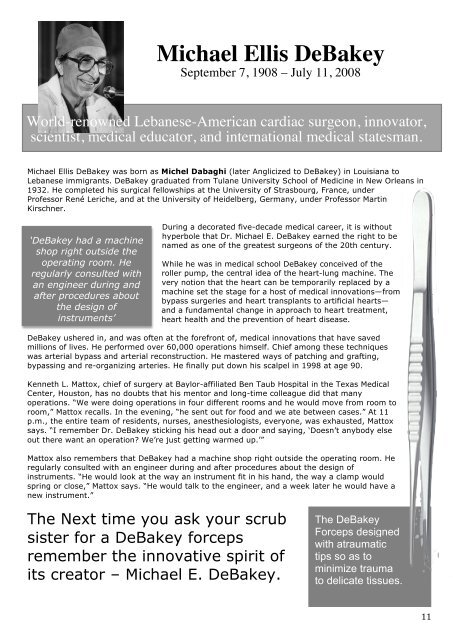January/February 2011 - SASSiT
January/February 2011 - SASSiT
January/February 2011 - SASSiT
- TAGS
- sassit
- www.sassit.co.za
You also want an ePaper? Increase the reach of your titles
YUMPU automatically turns print PDFs into web optimized ePapers that Google loves.
Michael Ellis DeBakey was born as Michel Dabaghi (later Anglicized to DeBakey) in Louisiana to<br />
Lebanese immigrants. DeBakey graduated from Tulane University School of Medicine in New Orleans in<br />
1932. He completed his surgical fellowships at the University of Strasbourg, France, under<br />
Professor René Leriche, and at the University of Heidelberg, Germany, under Professor Martin<br />
Kirschner.<br />
‘DeBakey had a machine<br />
shop right outside the<br />
operating room. He<br />
regularly consulted with<br />
an engineer during and<br />
after procedures about<br />
the design of<br />
instruments’<br />
Michael Ellis DeBakey<br />
September 7, 1908 – July 11, 2008<br />
World-renowned Lebanese-American cardiac surgeon, innovator,<br />
scientist, medical educator, and international medical statesman.<br />
During a decorated five-decade medical career, it is without<br />
hyperbole that Dr. Michael E. DeBakey earned the right to be<br />
named as one of the greatest surgeons of the 20th century.<br />
While he was in medical school DeBakey conceived of the<br />
roller pump, the central idea of the heart-lung machine. The<br />
very notion that the heart can be temporarily replaced by a<br />
machine set the stage for a host of medical innovations—from<br />
bypass surgeries and heart transplants to artificial hearts—<br />
and a fundamental change in approach to heart treatment,<br />
heart health and the prevention of heart disease.<br />
DeBakey ushered in, and was often at the forefront of, medical innovations that have saved<br />
millions of lives. He performed over 60,000 operations himself. Chief among these techniques<br />
was arterial bypass and arterial reconstruction. He mastered ways of patching and grafting,<br />
bypassing and re-organizing arteries. He finally put down his scalpel in 1998 at age 90.<br />
Kenneth L. Mattox, chief of surgery at Baylor-affiliated Ben Taub Hospital in the Texas Medical<br />
Center, Houston, has no doubts that his mentor and long-time colleague did that many<br />
operations. “We were doing operations in four different rooms and he would move from room to<br />
room,” Mattox recalls. In the evening, “he sent out for food and we ate between cases.” At 11<br />
p.m., the entire team of residents, nurses, anesthesiologists, everyone, was exhausted, Mattox<br />
says. “I remember Dr. DeBakey sticking his head out a door and saying, ‘Doesn’t anybody else<br />
out there want an operation? We’re just getting warmed up.’”<br />
Mattox also remembers that DeBakey had a machine shop right outside the operating room. He<br />
regularly consulted with an engineer during and after procedures about the design of<br />
instruments. “He would look at the way an instrument fit in his hand, the way a clamp would<br />
spring or close,” Mattox says. “He would talk to the engineer, and a week later he would have a<br />
new instrument.”<br />
The Next time you ask your scrub<br />
sister for a DeBakey forceps<br />
remember the innovative spirit of<br />
its creator – Michael E. DeBakey.<br />
The DeBakey<br />
Forceps designed<br />
with atraumatic<br />
tips so as to<br />
minimize trauma<br />
to delicate tissues.<br />
11

















